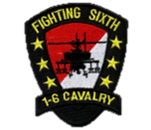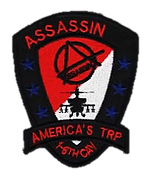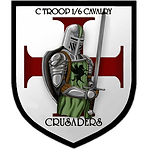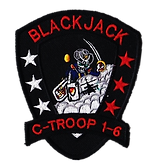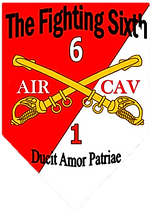
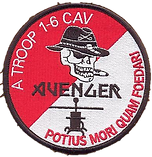
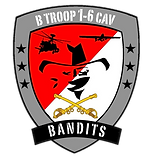
1st Squadron, 6th Cavalry
The Fighting Sixth
Fort Bliss, Texas
(1971 - 1973)
On 31 March 1971, the regiment (minus 1st Squadron) was inactivated at Ft. Meade, Maryland. The 1st Squadron would remain active for nearly two years, when it received orders to ship its equipment by rail to Ft. Bliss, where it inactivated on 21 June 1973. The following day the entire regiment was reorganized and redesignated as the 6th Cavalry, a parent regiment under the Combat Arms Regimental System (CARS).
Forts Rucker, Alabama & Hood, Texas
(1985 - 1995)
On 17 January 1985, the squadron was reactivated as one of the pioneering AH-64 Apache units in the Army. During the early 1980's the squadron was stationed at Fort Rucker, Alabama, and was known as an Armor Attack Helicopter Squadron. The squadron served as a leader in doctrinal development and validation for the AH-64 until its inactivation on 15 December 1995 at Fort Hood, Texas.
Camp Eagle, Korea
(1996 - 2006)
On 16 July 1996, the squadron was reactivated at Camp Eagle, Korea, near Wonju. The squadron acted as a combat multiplier to the combatant commander of US Forces Korea and a major deterrent to North Korea aggression in the defense of the Republic of Korea. While in Korea assigned to the 6th Cavalry Brigade, the squadron's mission was to, on order, transition to war and execute split base operations in designated assembly areas. It would conduct overwater attacks into a designated CSCA. On order, it would also attack deep to destroy enemy forces.
Fort Carson, Colorado
(2006 - 2007)
In 2006, as part of the reorganization of US Forces Korea and the transformation of the Army to the new modular force structure, the 6th Cavalry Brigade was inactivated. 1-6 CAV was also inactivated, before being reactivated from the reflagged 4/3 ACR at Fort Carson, Colorado, as part of the reorganized Combat Aviation Brigade, 1st Infantry Division (Mechanized).
In March 2007, 1-6 CAV performed night reconnaissance missions to identify transnational threats to assist in the interdiction of narcotrafficking and alien smuggling along the U.S. and Mexican border, in support of the U.S. Border Patrol. during Operation NIGHT OWL. While executing the border patrol support operation, the unit conducted concurrent military training in preparation for their future deployment to Iraq.
In October of 2007, 1-6 CAV deployed to Iraq in support of Operation IRAQI FREEDOM. Upon its RIP/TOA with its sister squadron (6-6 CAV) in Iraq, 2008, the squadron redeployed to Fort Carson, then immediately transferred to Fort Riley, Kansas, to join the rest of the 1st Combat Aviation Brigade. The squadron received campaign participation credit and earned the OIF campaign streamer (SURGE).
Fort Riley, Kansas
(2008 - Present)
Early in the spring of 2015, 1-6 CAV deployed to the National Training Center (NTC) as an aviation task force in preparation to deploy to Iraq. In the months following this rotation, the Squadron quickly shifted fires to focus on the transition of the Squadron to the new Heavy Armed Reconnaissance Squadron (H-ARS) structure as part of the Aviation Restructure Initiative (ARI).
Over the next year,1-6 CAV turned-in the OH-58D Kiowa Warrior helicopters and associated equipment. On 8 June 2015, the squadrons OH-58D Kiowa Warriors took their Ceremonial Final Flight in conjunction with 1st Infantry Division Victory week celebrations.
There were many milestones and challenges during this transition, including an NTC Rotation (10 March - 10 April 2015), Divestiture flights to Davis Monthan Airforce Base, Arizona and Redstone Arsenal, Alabama (1 - 31 July 2015), reception of 24 x AH-64Ds from the Army National Guard (15 October – 15 November 2015), RQ-7BV2 Fielding and New Equipment Training (25 January – 29 April 2016), AH-64D MUM-T equipping and modifications (July – September 2016), Aerial Gunnery (July 2016), Platoon and Troop EXEVALS (August – September 2016), and Saber FOCUS ( October 2016) the squadrons Major Field Training Exercise and Advanced Aerial Gunnery Tables. It also had an 80% turnover in personnel while receiving its AH-64D Longbow Apaches from the Army National Guard and RQ-7BV2 Shadow Unmanned Aircraft Systems (UAS).
At the end of the transition, the 1-6 CAV grew from having 6 x OH-58D platoons to having 6 x AH-64D platoons and 3 x RQ-7BV2 Shadow platoons. This new capability enabled each troop to execute Manned Unmanned Teaming (MUM-T) as an independent element with 2 x AH-64D platoons and an organic Shadow Platoon.
In September 2016, 1-6 CAV deployed to the field in order to conduct Exercise SABER FOCUS, in preparation for its deployment to Korea in 2017.
